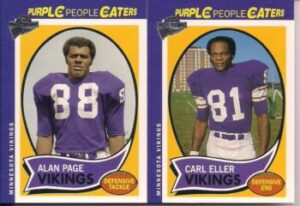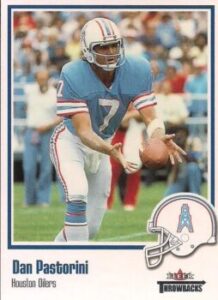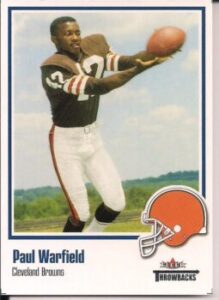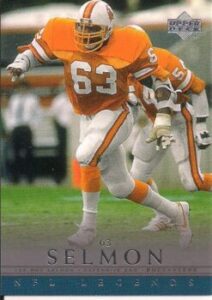You can call me old-fashioned– not with the times, a dinosaur–but I miss 1970s football. Perhaps it meant so much to me because of my age. I was eight years old in 1970 and 17 years old in 1979. For most people, so many of life’s memories are between the ages of 8 and 17. I can remember it all like it was yesterday. I played football and watched it with equal enthusiasm.
1970s NFL football was, and still is, a big part of my life. I was–and as my wife can attest to–sometimes still am obsessed with it.
My interest started with 1969 Topps football cards. I read and studied those cards over and over. Then I started reading football books and magazines and watching the games on TV. I was hooked. It was like an addiction.

I watched all the football shows that were on TV at the time. There was This is the NFL, This Week in Pro Football, the NFL Game of the Week, NFL Films with Ed and Steve Sabol. I was like an encyclopedia on NFL football. I knew every player, every statistic, every score, and every team’s record and history. I absolutely loved it.
Then, suddenly, I wasn’t 17 anymore, and the 1970s became the 1980s. Football was still a big part of my life, but not the same way it was in the 1970s. I grew into adulthood and did the things adults do, like go to work, move out of my parent’s house, get my own house, get married, have children, and pay the bills.
Football wasn’t as important anymore. Not only had I changed, but the game had changed, too. Many rule changes took place in the 1980s, and today’s game bears little resemblance to the game I watched and played in the 1970s.
An End of An Era
I pretty much stopped watching football altogether around sixteen years ago. Up until a few years ago, I’d watch some of the playoff games and the Superbowl, but I don’t even watch that anymore. The modern game bores me! I’d much rather go to YouTube and watch a game from the 1970s than any of the current games.
Not only does that bring back fond memories, but it’s fun to compare how the game was then and what it has become.
Football today has become big business–entertainment at its best, or worst, depending on your opinion.
The conflict for me is I’m not interested in entertainment. I’m interested in football.
So let us now look at 1970s football compared to today’s game.
We’ll start with the pre-game show. In the 1970s, the pre-game show was 30 minutes. I always looked forward to watching Brent Musburger, Irv Cross, Phyllis George, and Jimmy the Greek. They would talk about the games scheduled for that day, talk about the players, give an opinion, or give an injury update. Then Jimmy the Greek would make his predictions, and it was time to kick the ball off. Today we have hours and hours of non-stop blabbering and the never-ending question, “What’s the key to the game?”
We get the same answers as always. Don’t turn the ball over. Don’t commit too many penalties. Don’t make stupid mistakes. Put pressure on the quarterback. Do they think we don’t already know this?


A Different Style of Play
From the opening kickoff, I’m annoyed. Every stadium must now have loud booming music blasting from the P.A. system. I guess the game itself is not enough to hold the interest of the average fan.
The football is now kicked off from the 35-yard line instead of the 30-yard line. The ball usually goes into the end zone and is downed for a touchback–removing one of the most exciting plays in the game. I’m talking, of course, about the kickoff return.
When’s the last time you saw a return man break off a big return, or better yet, take it all the way for a touchdown?
It hardly ever happens anymore. I understand the NFL wants to cut down on injuries. But come on! You can’t take away one of the most exciting plays in the game. But they did.
Since there are very few kickoff returns now, the receiving team starts at the 25-yard line, and immediately the passing frenzy begins. The percentage of passing plays in the NFL today is much higher than the percentage of running plays. The opposite was the case in the 1970s.
The rules have changed drastically to allow for more passing, and more passing means more scoring. But for old-school fans like me, there was nothing like watching a strong running attack. There were so many great running backs in the 1970s and the 1980s, as well.
John Riggins, Tony Dorsett, Walter Payton, Eric Dickerson, Larry Csonka, Franco Harris, Earl Campbell, and more. These guys and a strong offensive line could take over a game. With a dominant running attack, you didn’t need to throw the ball a lot. Take, for example, the 1972 & 1973 Miami Dolphins. So dominant was their ground game that QB Bob Griese only threw the ball a combined 18 times in Super Bowls VII & VIII.

We old-school football fans miss the great defensive battles of the 1970s. Scores like 13–6, 10–7, and 7–3 weren’t unusual.
With defenses like The Doomsday Defense, The Over the Hill Gang, The Purple People Eaters, The Fearsome Foursome, The No-Name Defense, The Orange Crush, and last but not least, The Steel Curtain, high scoring was not at a premium.

Distractions From The Game
My next complaint is the graphics all over the TV screen. What’s with all the graphics? I find all the blue lines, yellow lines, and red lines very distracting. I don’t need a yellow line to tell me where the first down marker is located. If it’s first and ten, and the ball is on the 22-yard line, it’s not that hard to figure out that a team needs to get to the 32-yard line to get a first down.
And the announcers–particularly the analysts–never shut up! The incessant talking is unnecessary. I don’t need them to explain every little detail of the game. The average fan doesn’t care, and for the most part, the hardcore fan already knows the game. Take a breath and let the game speak for itself.
Quarterbacks and Receivers New Expectations
Then there’s the never-ending complaining by quarterbacks and receivers. Some call it gamesmanship. I call it complaining. I will not say it’s all the quarterbacks, but a lot of them are in a referee’s ear every time they get hit. Okay, sometimes they do get hit a little late, but rule changes put a premium on protecting the QB.
Quarterbacks of yesteryear were the target of many a cheap shots, and they rarely complained. It’s good that the NFL is doing more to protect QBs from unnecessary late hits and cheap shots, but you can only do so much. Football is a game of hitting, and QBs are going to get roughed up, just like every other player on the field.
If a quarterback complained back in the 1970s (and most didn’t), that only made defenders want to hit them harder. That’s how it was back then.

And what about all the ways QBs can stop the clock? They can spike the ball into the ground, and intentionally ground the ball (as long as they’re out of the pocket). None of that was allowed up until the 1990s. In my opinion, these types of rules cheapen the game.
And then there’s that crazy tuck rule. What’s that all about? Who came up with that one? It used to be that if a defender knocked the ball out of your hand before you could throw it, it was a fumble. It seems pretty obvious. Why complicate things?
The receivers are even worse. They complain to the referee about interference almost every time they don’t catch the ball. In my opinion interference should only be called when it’s obvious. There’s always going to be some pushing, grabbing, and shoving such that you could call interference on almost every pass play–if you want to. John Madden once said that if he were coaching today, he’d have his QB throwing long on almost every play. Why? Because half the time, defensive pass interference is called.

Beyond The Gameplay
Then there are those uniforms! UGLY!! Some games look like the teams are at a pajama party. All green, all blue, or all red. How am I supposed to take the game seriously when the players are wearing uniforms that look like pajamas? In my opinion, the 1970s had the sharpest-looking uniforms in NFL history. I can’t think of any team that had a bad looking uniform.

Then there’s the excessive celebrating, including all the dancing and the chest-thumping. I have nothing against a player getting excited or showing genuine emotion, but the excessive showboating and taunting are immaturity and poor sportsmanship. How about showing a little humility?
Make a great play. Get back in the huddle and make another great play. That’s what they’re paying you for.
Was there showboating in the 1970s? Yes, there were some, but not to the degree there is today. The excessive celebrating really started in the 1980s with Mark Gastineau and his sack dance. I was as against it then as much as I am now. Show some professionalism, sportsmanship, and class.

The Viewing Experience
The commercials…there are too many, and many are just so bad. I don’t know how anyone can sit through all those commercials. In the 1970s, they would show two or three commercials and then get you back to the game. Today it seems they spend more time on commercials than they do on the game. They used to take a brief time out to show a couple of commercials. But today, they take a brief timeout from the commercials to show you the game. When I was still watching football, I would usually record the games I was interested in, so I could fast-forward through the commercials. It would usually take only about one and a half hours to watch the game without commercials.
The Super Bowl halftime shows are, well…. Up until the mid-1970s, the halftime show at the Super Bowl consisted of bringing out the marching band. Once the band was done performing, they got back to playing football. Now the halftime show has become such a spectacle that the game doesn’t resume until about 40 minutes later, and the players usually return to a stadium filled with smoke.
Instant Replay — There are few things about the game that drive me crazier than instant replay.
Instant Replay started out as a good idea, used on truly controversial plays. Now it’s used to create controversy.
More controversy means more revenue, and the announcers play into it even though they know it’s ridiculous. Why? Because they don’t want to bite the hand that feeds them. John Madden was one of the few announcers who would not play into that. He wasn’t afraid to point out when an interference call was just nit-picking and when a replay was unnecessary or taking too long.
There’s supposed to be a time limit on replays, but they never abide by it. Replays should only be used for truly controversial calls, and they should have no more than one minute to look at it. If you don’t see conclusive evidence to overturn the call in that minute, the call stands. I don’t need to see the same play replayed over and over again from ten different angles. It’s boring! Make a decision, and let’s get back to the game.
Multiple "Enhancements" To The Game
The rulebook is probably twice as long now as it was in the 1970s. The rules are far more complicated than they need to be. Once again, I believe this was done to create more controversy. The rules of what constitutes a catch are ludicrous! It seems like there is a review every time a receiver catches the ball. If a receiver has possession of the ball–meaning the ball never touches the ground until he hits the ground–it should be considered a catch. It shouldn’t need to be more complicated than that.
The playoff system is overdone. First, I think seven teams from each conference are way too many. I think five is more than enough. Four might even be enough. I never liked the idea of a 9–7 team getting in the playoffs, much less a team with an 8–8 record or a 7–9 record. The way I see it, it kind of makes the regular season meaningless.
Winning your division with a 9–7 record simply means you were in a lousy division.
I think you should need to have at least ten wins to reach the playoffs.
Kneeling for the National Anthem. It upset a lot of people and made a lot of people angry. I would never suggest we deny someone the right to protest but do it respectfully. What the players are protesting has nothing to do with the National Anthem. I think it is very disrespectful, especially to those who have served this country. Many have died serving this country and defending that flag. There are many ways to protest injustice. I don’t think disrespecting our National Anthem is a very respectful way to protest.
Domed stadiums and football? They started playing NFL games indoors in the 1970s. The Houston Oilers were the first to do it, followed by the New Orleans Saints, the Detroit Lions, and the Seattle Seahawks. I didn’t like it then. I don’t like it now. Today, numerous teams play in domed stadiums, and almost all the stadiums from the 1970s have been demolished. The two I miss the most are Metropolitan Stadium, where the Vikings played, and Memorial Stadium, where the Colts played.
The Minnesota Vikings not playing outdoors? There’s just something very wrong with that.
Before you think I’m just a grumpy old man who’s complaining that things aren’t the way they used to be, I’d like to point out some aspects of the game that I think have improved since the 1970s.
The two-point conversion. I like the decision to add the two-point conversion. I think it adds more excitement to the game. I’d like to see it used more often.
Artificial turf. Don’t get me wrong. I’d still like to see all games played on real grass, but at least the synthetic turf they’re playing on now is better than what they were playing on in the 1970s and 1980s, which was basically concrete with a carpet on top of it. Many careers were cut short by having to play on that surface. The worst ones were the stadiums that were used for both football and baseball. Players would get their cleats caught in the cut-out seams and patches and tear up a knee.

Some Positive Changes I've Seen
Helping those in need. As much as there is to criticize the NFL and its players for, one thing they have always been good at is helping out those who are less fortunate. I think today, even more than ever before, the league and its players are giving back. They should be commended for it.
It’s good to see the NFL taking injuries more seriously than in the past, especially concussions. Too many former players have suffered, and still are suffering, from injuries and concussions they suffered while playing. They were not taken care of as they should have been. Hopefully, that is changing, and today’s players will not have to suffer as their predecessors did. The concussion protocol is a step in the right direction. No player should be playing with a concussion as they did years ago. Perhaps they didn’t know the long-term dangers of concussions years ago, but they do now. So I’m glad to see they are taking it seriously.
I’m also glad to see advancements in the medical field with respect to knee injuries. A serious knee injury in the 1970s was many times career-ending or, at the very least, it shortened your career. Today, thanks to better surgical procedures and advancements in rehabilitation, a player can come back from a serious knee injury.

If you’re a fan of 1970s football, you may have the same gripes I do. If you’re a fan of today’s game, enjoy it! I’m not trying to convince anyone they shouldn’t watch it; I’m just stating why I don’t. I try to watch it every once in a while, but I usually get bored after 10 minutes. So, if you’re like me, go to YouTube and find a game from the 1970s, the Golden Era of Football.
You can also purchase my book titled Reliving 1970s Old School Football or The NFL in the 1970s by fellow Sports History Network podcaster Joe Zagorski. Both books are available on Amazon.com.
Please Share This Post If You Enjoyed
Mark Morthier is the host of Yesterday’s Sports, a podcast dedicated to reliving memorable sports moments from his childhood days and beyond. He grew up in New Jersey just across from New York City, so many of his episodes revolve around the great sport’s teams of the 70s for the New York area.
He is also an author of No Nonsense, Old School Weight Training (Second Edition): A Guide for People with Limited Time and Running Wild: (Growing Up in the 1970s)

Please Note – As an Amazon Associate I earn from qualifying purchases
More From Yesterday's Sports
Debating the Pro Football Hall of Fame: Who Truly Deserves Induction?
I belong to several old-school football groups on Facebook, and...
Read MoreStefan Botev: The Unforgettable Story of a Weightlifting Phenomenon
One of my favorite weightlifters to watch was Stefan Botev....
Read More1974 Miami Dolphins: Chasing Super Bowl Greatness
After appearing in three straight Super Bowls and winning two,...
Read MoreInterview with Steve Wright: NFL Veteran, Entrepreneur, and Survivor Contestant
I recently had the opportunity to interview Steve Wright, who...
Read More
